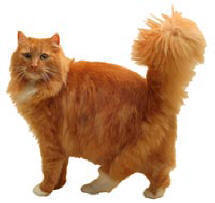Some
cats seem to nurse on clothes
or objects while they knead
with their paws. While doing
this they usually seem quite
content and happy. As with any
behavior concern, the first
question to ask is, "Is
this really a problem?" In some cases, we can ignore
it, or even vicariously enjoy
the pastime. This behavior is
seen more often in cats who
are weaned early, suggesting
the weaning process may not
have been completed.
|
As
with any behavior concern,
the first question to ask
is, "Is this really
a problem?" In some
cases, we can ignore it,
or even vicariously enjoy
the pastime. |
 When
is it a problem? One thing to
look for is if the cat is really
chewing, which is defined as
using carnassial (molar)
teeth. The second issue is
whether or not he or she is swallowing material.
In the latter case, the concern
is for a possible intestinal
When
is it a problem? One thing to
look for is if the cat is really
chewing, which is defined as
using carnassial (molar)
teeth. The second issue is
whether or not he or she is swallowing material.
In the latter case, the concern
is for a possible intestinal
 obstruction.
The recommendations for true
inappropriate chewing are to redirect the
cat's chewing to something more
desirable such as a high fiber
cat treat, and to increase the
fiber in the diet such as bran
fiber, or grated carrots or
celery mixed in with the regular
food. Also, provide the cat with
an indoor garden that is safe
to chew such as the "cat
grass" sold in pet stores.
Eating a small amount of chlorophyll
laden grass falls within a normal diet
for a cat.
obstruction.
The recommendations for true
inappropriate chewing are to redirect the
cat's chewing to something more
desirable such as a high fiber
cat treat, and to increase the
fiber in the diet such as bran
fiber, or grated carrots or
celery mixed in with the regular
food. Also, provide the cat with
an indoor garden that is safe
to chew such as the "cat
grass" sold in pet stores.
Eating a small amount of chlorophyll
laden grass falls within a normal diet
for a cat.
 The
second thing to consider is
whether or not behavior modification
is indicated. Does this behavior
seems to fit the criteria for
obsessive compulsive disorder?
The tip off here is when the
cat continues excessively in
the face of efforts to redirect
or stop the behavior. In a true
obsessive compulsive disorder,
the pet gets relief from anxiety
by participating in the
compulsive behavior. These cases
usually require psychoactive
medication for relief.
The
second thing to consider is
whether or not behavior modification
is indicated. Does this behavior
seems to fit the criteria for
obsessive compulsive disorder?
The tip off here is when the
cat continues excessively in
the face of efforts to redirect
or stop the behavior. In a true
obsessive compulsive disorder,
the pet gets relief from anxiety
by participating in the
compulsive behavior. These cases
usually require psychoactive
medication for relief.
|
The recommendation for
inappropriate chewing is to redirect the chewing
to something more
desirable such as a high fiber
cat treat. |
 For
those cases where the behavior
occurs more than desired, but is
not obsessive compulsive, a
milder, easier regime is
indicated - stand up and walk
away. This is what the mother
cat does during the weaning
process. It may help to increase
exercise like chasing a string.
It may also help to increase the
tactile stimulus such as petting
and massaging as long as the cat
is NOT suckling and kneading. In
some cases, food treats are
used. The idea here is to first
determine the timing or
circumstances when the behavior
occurs. Give healthy tasty kitty treats (high quality
commercial treats, freeze dried
liver, or small frozen pieces
of tinned shrimp or chicken.)
when the cat is on your lap
before kneading or suckling begins.
If the cat starts either,
get up and move or move the
cat off your lap.
For
those cases where the behavior
occurs more than desired, but is
not obsessive compulsive, a
milder, easier regime is
indicated - stand up and walk
away. This is what the mother
cat does during the weaning
process. It may help to increase
exercise like chasing a string.
It may also help to increase the
tactile stimulus such as petting
and massaging as long as the cat
is NOT suckling and kneading. In
some cases, food treats are
used. The idea here is to first
determine the timing or
circumstances when the behavior
occurs. Give healthy tasty kitty treats (high quality
commercial treats, freeze dried
liver, or small frozen pieces
of tinned shrimp or chicken.)
when the cat is on your lap
before kneading or suckling begins.
If the cat starts either,
get up and move or move the
cat off your lap.
 One
last suggestion. Since this
behavior is affiliative (wanting
to affiliate), you might look
for a cat companion that seems
to really like physical contact.
There is no problem with cats
suckling on each other as long
as no hair is being swallowed.
They are quite capable of setting
their own personal limits, since
they "speak the same language."
One
last suggestion. Since this
behavior is affiliative (wanting
to affiliate), you might look
for a cat companion that seems
to really like physical contact.
There is no problem with cats
suckling on each other as long
as no hair is being swallowed.
They are quite capable of setting
their own personal limits, since
they "speak the same language."